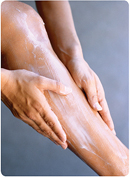Moisturizers are a critical part of a skin care regimen and daily use is particularly important for people with atop ic dermatitis or other forms of eczema.
ic dermatitis or other forms of eczema.
Moisturizers nourish dry skin, prevent fine lines and wrinkles, and protect sensitive skin.
Moisturizers work by hydrating the skin (pulling moisture into the skin) or preventing water loss from the skin.
Moisturizers are generally available in three formulations:
- Lotions are the lightest form and are usually used for mild dryness of the skin and scalp.
- Creams are slightly heavier than lotions and often recommended for skin on the torso, arms, and legs.
- Ointments are the thickest kind of moisturizer, designed to stay on the skin for as long as possible; they are often formulated with such oil-based ingredients as petroleum jelly or liquid paraffin. Most people with normal skin find ointments too greasy; they are often recommended for extremely scaly dry skin, such as in people with psoriasis.
It may be confusing to find the right moisturizer for your skin type. No one moisturizer is suitable for every skin type, and different people have different sensitivities. Faced with so many choices, it’s helpful to know a little about what goes into moisturizers.
Common moisturizer ingredients
The ingredients listed for most moisturizers usually have foreign-sounding names that give no clue about what they do. Here are a few common ingredients:
- Humectants moisturize by attracting water from the environment into the skin. Examples include urea, glycerin, alpha hydroxy acids, and lactic acid.
- Emollients soothe and soften the skin by preventing water loss and helping replace oils (lipids). They can be water-based or oil-based. Examples include butyl stearate, glycerin, lanolin, mineral oil, petrolatum, cocoa butter, and shea butter.
- Fragrances are found in most moisturizers and are meant to add a pleasing odor, but they can trigger contact allergies or other forms of skin irritation in some people. The fragrances most likely to cause reactions are alcohol-based, such as cinnamic alcohol, as well as hydroxycitronella and isoeugenol.
- Preservatives (such as quaternium-15, imidazolidinyl urea, and parabens) are added to moisturizers to keep them from becoming contaminated, but these ingredients may cause skin irritation in some people.
Other ingredients include vitamins, plant extracts, and sunscreens.
Choosing the right moisturizer for your skin
The right moisturizer for you probably depends on such factors as your age, your skin’s sensitivity to certain ingredients, any skin conditions you have, and your skin type. There are four basic skin types:
- Normal skin. Not too dry or oily, normal skin is best moisturized with a light, non-greasy, water-based product.
- Dry skin. To keep moisture in, people with dry skin should use heavier, oil-based products with urea or other humectants, as well as propylene glycol to keep the skin moist. The heavier oils will keep water in the skin from evaporating.
- Oily skin. To prevent acne and other problems of oily skin, choose a light, water-based moisturizer, preferably one that is labeled “non-comedogenic.” This is particular important for those prone to developing acne.
- Sensitive skin. This skin type is more susceptible to reactions from ingredients like fragrances or dyes, so choose hypoallergenic products that are labeled fragrance-free.
Another consideration is aging skin, because your skin tends to become drier as you get older. In addition to sun-avoidance measures, protect your skin from the aging process by choosing oil-based products with a petrolatum base that include lactic acid or alpha-hydroxy acids to hold in moisture.
Moisturizer tips
To get the most out of your moisturizing regimen, observe a few simple tips:
- Before trying a moisturizer on a large area of skin, patch-test it on a small part of your face or wrist to make sure your skin doesn’t react to it.
- The most expensive moisturizers aren’t always the best ones.
- Moisturize your skin immediately after bathing, ideally within three minutes. Pat-dry your skin to keep water in, and then apply moisturizer immediately to prevent water evaporation.
- Don’t ignore your hands when moisturizing—try to apply a lotion or cream to your hands each time you wash them, exercise outdoors, or bathe.
- Avoid using heavy creams or ointments on your face unless you have exceptionally dry skin there, or you could clog your pores.
If you haven’t been able to find the right moisturizer or you find that your skin reacts to the products you are using, talk to your doctor who can help recommend the best moisturizer for your skin type.
Source: Vivacare
Last updated : 1/15/2019